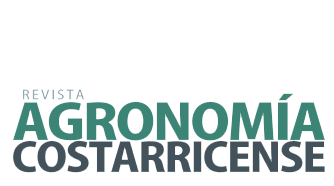Relación entre metodologías de determinación de conductividad eléctrica y concentración de cationes solubles en suelos de Costa Rica
DOI:
https://doi.org/10.15517/vf5xpa16Palabras clave:
extracciones de suelo, pasta saturada, diagnóstico de salinidad, análisis de suelos, composición de aguas, concentración de salesResumen
Introducción. La conductividad eléctrica del extracto de pasta saturada (CE(e)) es el método estándar para evaluar el impacto de la salinidad en los cultivos, pero su implementación en laboratorio presenta limitaciones que afectan su reproducibilidad. Estudios previos han relacionado la CE(e) con mediciones de CE obtenidas en extracciones suelo/agua. Sin embargo, la variabilidad de los suelos y de los métodos empleados hacen necesario validaciones específicas para suelos de Costa Rica. Objetivo. Establecer la relación entre la CE en extractos de pasta saturada y en dos extracciones suelo/agua, y validar la relación entre CE y suma de cationes (SC) solubles en extractos de suelo y muestras de aguas naturales y agrícolas en Costa Rica. Materiales y métodos. Se midió la CE en suelos mediante tres metodologías: pasta saturada, y en extracciones (1:2,5) relación volumétrica y (1:5) masa/volumen. Se cuantificó la concentración de cationes solubles (Ca, Mg, K, Na) mediante ICP-OES en extractos de suelo y muestras de aguas. Los factores de conversión (fc) entre CE(1:2,5)/CE(1:5) y CE(e), así como la relación CE-SC, se determinaron mediante análisis de regresión. Resultados. Los fc obtenidos para CE(1:2,5)-CE(e) y CE(1:5)-CE(e) fueron 3,00 y 4,30, respectivamente. A partir de estos fc, se establecieron valores críticos de CE(1:2,5) y CE(1:5) para cultivos sensibles y moderadamente sensibles a la salinidad. La robusta relación lineal CE-SC valida el uso del factor de proporcionalidad K = 10 para estimar SC (mmol(+) L-1) a partir de CE (dS m-1). Conclusiones. Las extracciones (1:2,5) y (1:5) son métodos prácticos para estimar CE(e). Los resultados permitirán estandarizar la interpretación de CE en suelos de Costa Rica, lo cual tiene implicaciones para fines de manejo de este recurso. La relación CE-SC respalda el uso de CE como herramienta rápida para estimar la concentración de sales solubles en extractos acuosos suelos y muestras de aguas de Costa Rica.
Descargas
Publicado
Número
Sección
Licencia

Esta obra está bajo una licencia internacional Creative Commons Atribución-NoComercial-SinDerivadas 4.0.
El autor, la autora o los autores deben autorizar por escrito a la Revista Agronomía Costarricense el derecho de su publicación y mención que quedará registrada con la licencia Creative Commons Atribución-NoComercial-SinDerivar 4.0 Internacional y conserva todos sus derechos; además, podrán incluir su publicación en un repositorio institucional aclarando su publicación en primera instancia en la Revista Agronomía Costarricense.
Una vez publicado el volumen del periodo respectivo, se puede acceder a la versión digital, lo que permite gestionar un autoarchivo del documento o documentos de interés, en el sitio seleccionado por la persona autora.
El autor o la autora principal, debe dar fe por escrito, que la información presentada es original y no ha sido publicada en ningún otro medio. Además, desde el momento que entrega la documentación, debe contar con la autorización de la institución donde se realizó la investigación.




